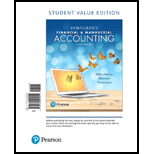
Concept explainers
1. and 2.
Accounting Cycle: The accounting cycle refers to the entire process of recording the accounting transactions of an organization and then processing them. The accounting cycle starts when a transaction takes places and it ends at the time when these transactions are recorded in the financial statements of the company.
The following are the rules of debit and credit:
- 1. Increase in assets and expenses accounts are debited. Decrease in liabilities and
stockholders’ equity accounts are debited. - 2. Increase in liabilities, revenues, and stockholders’ equity accounts are credited. Decreases in all asset accounts are credited.
To Record: The adjusting journal entries in books during January.
4.
Closing entries: These refers to the journal entries that are recorded at the end of an each accounting period. It closes all revenue accounts earned, and all expenses account incurred during the current accounting year to the income summary account.
To Record: The closing entries of Incorporation D for the month January.
1. and 2.
T Accounts: T- accounts are prepared for all the business transactions. First, journal entries are passed and then transferred to the respective ledger accounts where they are recorded, and summarized in either side of the ‘T’ format. It is divided into two parts by a vertical line, that is, the left side and the right side. The left side of the T-account is known as the debit side, and the right side of the T-account is known as the credit side. The account name appears on the top of the T-account.
To Post: The above journal entries and adjusting entries to T-accounts of Incorporation C.
(3)
Single-step income statement: It is an income statement format in which a single subtotal of all revenue items are listed in one column and a single subtotal of all expense items including cost of goods sold are listed in another column. Thus, the subtotal of all expense items is deducted from the subtotal of all revenue items to arrive at the net income at the bottom of the statement.
To Prepare: The income statement for the year ended January 31, 2019 of Company C.
(4)
Prepare trial balance for C Company as on January 31, 2019.
5.
Gross profit percentage is the financial ratio that shows the relationship between the gross profit and net sales. Gross profit is the difference between the total revenues and cost of goods sold. It is calculated by using the following formula:
To Calculate: The gross profit percentage of Company C.
Want to see the full answer?
Check out a sample textbook solution
Chapter 5 Solutions
Horngren's Financial & Managerial Accounting, Student Value Edition (6th Edition)

 AccountingAccountingISBN:9781337272094Author:WARREN, Carl S., Reeve, James M., Duchac, Jonathan E.Publisher:Cengage Learning,
AccountingAccountingISBN:9781337272094Author:WARREN, Carl S., Reeve, James M., Duchac, Jonathan E.Publisher:Cengage Learning, Accounting Information SystemsAccountingISBN:9781337619202Author:Hall, James A.Publisher:Cengage Learning,
Accounting Information SystemsAccountingISBN:9781337619202Author:Hall, James A.Publisher:Cengage Learning, Horngren's Cost Accounting: A Managerial Emphasis...AccountingISBN:9780134475585Author:Srikant M. Datar, Madhav V. RajanPublisher:PEARSON
Horngren's Cost Accounting: A Managerial Emphasis...AccountingISBN:9780134475585Author:Srikant M. Datar, Madhav V. RajanPublisher:PEARSON Intermediate AccountingAccountingISBN:9781259722660Author:J. David Spiceland, Mark W. Nelson, Wayne M ThomasPublisher:McGraw-Hill Education
Intermediate AccountingAccountingISBN:9781259722660Author:J. David Spiceland, Mark W. Nelson, Wayne M ThomasPublisher:McGraw-Hill Education Financial and Managerial AccountingAccountingISBN:9781259726705Author:John J Wild, Ken W. Shaw, Barbara Chiappetta Fundamental Accounting PrinciplesPublisher:McGraw-Hill Education
Financial and Managerial AccountingAccountingISBN:9781259726705Author:John J Wild, Ken W. Shaw, Barbara Chiappetta Fundamental Accounting PrinciplesPublisher:McGraw-Hill Education





